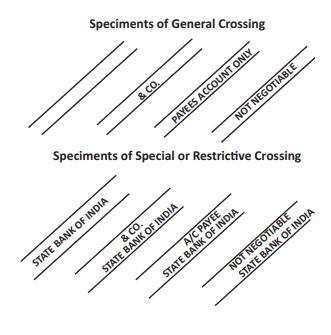The Negotiable Instruments Act 1881 - Crossing of Cheque | 12th Commerce : Chapter 22 : The Negotiable Instruments Act 1881
Chapter: 12th Commerce : Chapter 22 : The Negotiable Instruments Act 1881
Crossing of Cheque
Crossing of Cheque

Crossing a cheque refers to the practice of drawing
two parallel transverse lines across the face of a cheque with or without the
words ‘and Co’. The effect of this crossing is that the drawee bank will pay
the amount of a cheque only to the banker.
Crossing is of two types
• General Crossing and
• Special Crossing
Types of Crossing
• General Crossing
According to section 123 of the Negotiable
Instruments Act, 1881,
“Where a cheque bears across its face an addition
of the words “and company” or any abbreviation thereof, between to parallel
transverse lines or of two paralleltransverse lines simply, either with or
without the words “not negotiable” that addition shall be deemed a crossing and
the cheque shall be deemed to be crossed generally”.
The lines should be drawn across the face of a
cheque and not on the reverse thereof. Further, they must by parallel and
transverse. Cross marks such as ‘X’ does not constitute crossing. The words
‘and company’ or any abbreviation thereof are not an integral part of a
crossing and their omission does not affect the validity of crossing.
Significance of General Crossing
A crossed cheque should not be paid across the
counter. Even if the payee of a crossed cheque is well-know, the paying banker
is directed to make payment only through another banker. If the payee does not
have a bank account, he can collect it only through someone who is having a
bank account. As a result, even if a crossed cheque has been stolen and
collected for party not entitled to it, the person for whom it has been
collected can be easily traced. Thus crossing ensures safety and prevents
payment intro wrong hands.
• Special Crossing
Section 124 defines special crossing as follows:
“Where a cheque bears across its face an addition
of the name of a banker with or without the words “not negotiable”, that
addition shall be deemed a crossing and the cheque shall be deemed to be
crossed specially and to be crossed to that banker”.
Here that parallel transverse lines are not
essential. But the name of banker to whom the payment should be made is to be
necessarily written on the face of the cheque. Thus it must be noted that while
drawing of two parallel transverse lines is a ‘must’ for a general crossing,
the addition of the name of a banker constitutes the essential part of special
crossing.
Significance of Special Crossing
Here the paying banker should make payment only to
the particular banker named as a part of special crossing or to his agent for
collection. Thus special crossing is safer than general crossing.
Not Negotiable Crossing
The words not negotiable are sometimes included in
the general crossing or special crossing. Even with these words, the cheques
are transferable, but they are deprived of the special feature of
negotiability. “Such a cheque is like a stolen fountain pen or a watch, the
transferee of which does not get a better title than that of their”. It must be
clearly understood if there is no defect in the tile of the transferor, the
transferee for value of a cheque with the words ‘not negotiable’ gets good
title to it. The words ‘Not negotiable” have no effect unless they are put on a
crossed cheque.
Account Payee Crossing
Words such as “Account Payee” or Payee’s account
are also added to general or special crossing. Even though the addition of these
words has not legal sanctity, it has gained significance because of trade usage
and banking practice. These words constitute a direction to the collecting
banker to collect the amount of the cheque for the benefit of the payee’s
account only. If he credits negligently proceeds of the cheque to a wrong
account he loses the statutory protection given to him as a collecting banker.
Paying banker need not satisify himself that it is collected only for the
payee’s account. Though usually a banker will not collect an “Account Payee”
cheque for a person other than the payee, he does it in exceptional cases to
trusted customers.
Payee’s Position when Crossing is obliterated
Since crossing is a material part of the cheque,
crossing cannot be obliterated (removed) by a holder. But if the obliteration
has been done by dishonest persons so skillfully that its detection is
impossible and if payment has been made in due course, though at the counter,
the paying banker is discharged from liability.
Related Topics